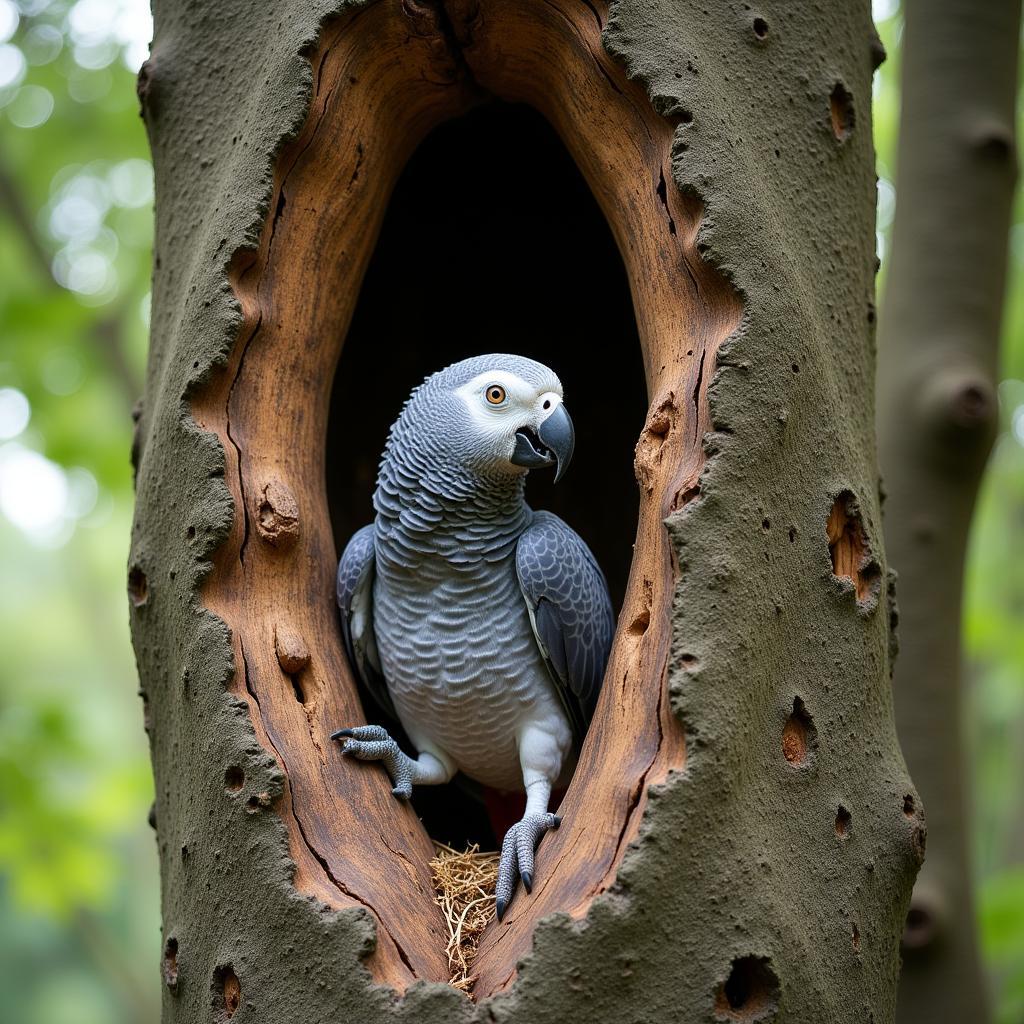Unveiling the Intricacies of African Grey Parrot Breeding Behavior
The African Grey Parrot, renowned for its exceptional intelligence and talking ability, captivates bird enthusiasts worldwide. Delving into the realm of African Grey Parrot Breeding Behavior unveils a fascinating tapestry of courtship rituals, nesting preferences, and parental dedication.
 African Grey Parrot Pair Engaging in Courtship Rituals
African Grey Parrot Pair Engaging in Courtship Rituals
The Dance of Courtship: A Symphony of Affection
Breeding season for African Grey Parrots, typically coinciding with the rainy season in their natural habitat, marks a period of heightened activity and vibrant displays. Males transform into ardent suitors, their usually calm demeanor replaced by a flurry of courtship rituals designed to entice a mate.
These captivating displays include:
- Bowing and Head Bobbing: A gentlemanly bow, often accompanied by rhythmic head bobbing, conveys the male’s interest and intentions.
- Vocal Serenades: The air fills with a chorus of whistles, clicks, and even mimicry of sounds, all aimed at capturing the female’s attention.
- Food Offerings: A symbolic gesture of provision, the male presents the female with choice morsels, demonstrating his ability to care for her and their potential offspring.
Nesting Preferences: Seeking Security and Comfort
Once a pair bond forms, the search for a suitable nesting site begins. In the wild, African Grey Parrots exhibit a preference for the secluded hollows of mature trees, seeking protection from predators and the elements.
 African Grey Parrot Nest in a Tree Hollow
African Grey Parrot Nest in a Tree Hollow
When breeding in captivity, it’s crucial to provide spacious nesting boxes that mimic their natural preferences:
- Dimensions: Opt for a box with dimensions around 18″ x 18″ x 24″, offering ample space for both parents and their chicks.
- Material: Choose sturdy, non-toxic wood that can withstand the parrots’ beaks and claws.
- Entry Hole: Position an entry hole high enough to offer a sense of security.
- Nesting Material: Provide a layer of soft, absorbent bedding, such as wood shavings or shredded paper.
Parental Dedication: Shared Responsibilities and Unwavering Care
African Grey Parrots exemplify avian parental dedication, sharing the responsibilities of incubation and chick rearing. The female typically lays a clutch of 2-5 eggs, with incubation duties shared between the pair.
 African Grey Parrot Parents Feeding Chicks
African Grey Parrot Parents Feeding Chicks
During the incubation period, which lasts around 30 days, the male diligently brings food to the nesting female, ensuring her well-being. Once the chicks hatch, both parents participate in feeding, nurturing, and protecting their vulnerable offspring. The young parrots remain reliant on their parents for several months, gradually developing their independence and foraging skills.
Ensuring Successful Breeding: Factors to Consider
Creating an environment conducive to successful breeding requires attention to detail and a deep understanding of the parrots’ needs:
- Nutrition: A varied diet rich in fruits, vegetables, high-quality pellets, and occasional nuts is essential for breeding readiness and chick health.
- Environmental Enrichment: Providing ample space, toys, and opportunities for social interaction stimulates natural behaviors and reduces stress.
- Health: Regular veterinary checkups, including disease screening and nutritional assessments, are vital for maintaining breeding pairs in optimal condition.
FAQs: Unraveling Common Queries about African Grey Parrot Breeding
Q: How can I tell if my African Grey Parrots are bonded?
A: Bonded pairs exhibit a range of affectionate behaviors, such as preening each other’s feathers, sharing food, and spending time in close proximity.
Q: What should I do if my parrots lay infertile eggs?
A: Infertile eggs can occur for various reasons, including nutritional deficiencies or underlying health issues. Consult an avian veterinarian to determine the cause and explore solutions.
Q: How long does it take for African Grey Parrot chicks to fledge?
A: Chicks typically fledge, or leave the nest, at around 10-12 weeks of age. However, they remain dependent on their parents for several more weeks.
Seeking Further Insights?
Explore our comprehensive guides on:
- African grey parrot for sale cheap: Discover reputable breeders and ethical purchasing options.
- African grey chicks for sale uk: Find healthy and well-socialized African Grey chicks in the UK.
- African grey flight cage: Choose the ideal flight cage to provide your parrots with ample space and enrichment.
Understanding the intricacies of African grey parrot breeding behavior is not only fascinating but also essential for responsible breeders and owners alike. By replicating their natural environment, providing optimal care, and fostering a deep understanding of their needs, we can contribute to the well-being of these intelligent and captivating creatures.



